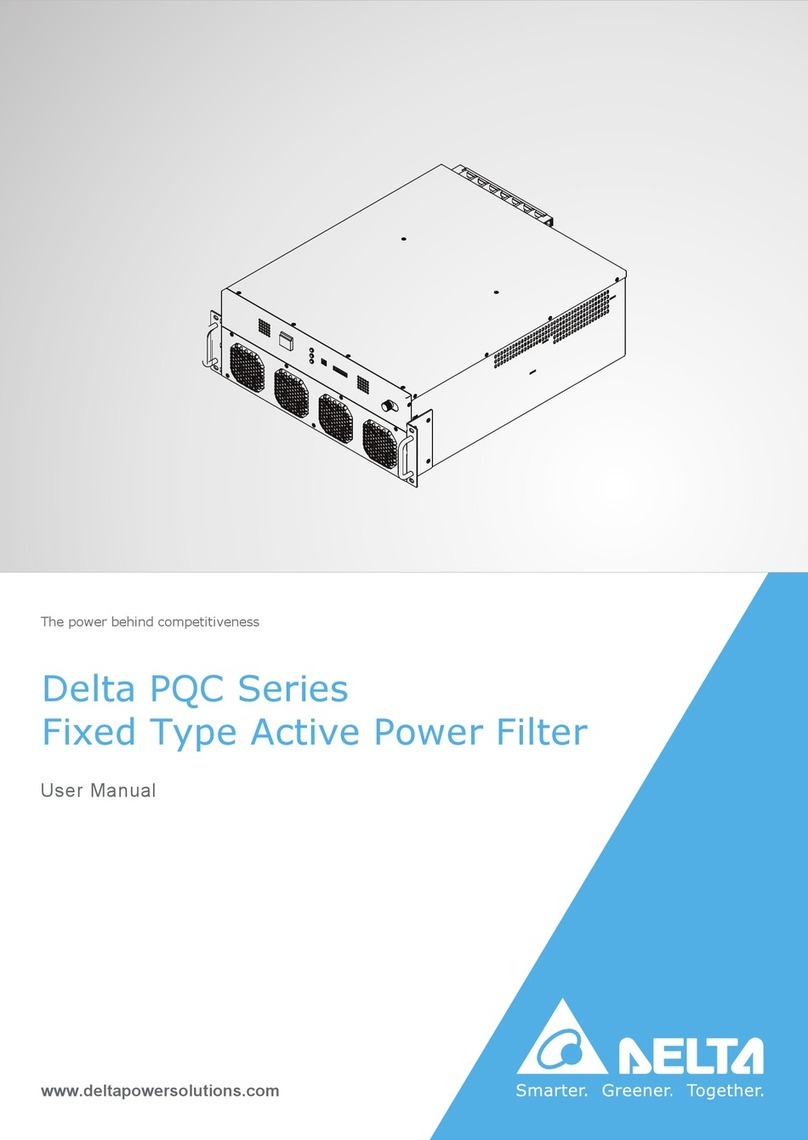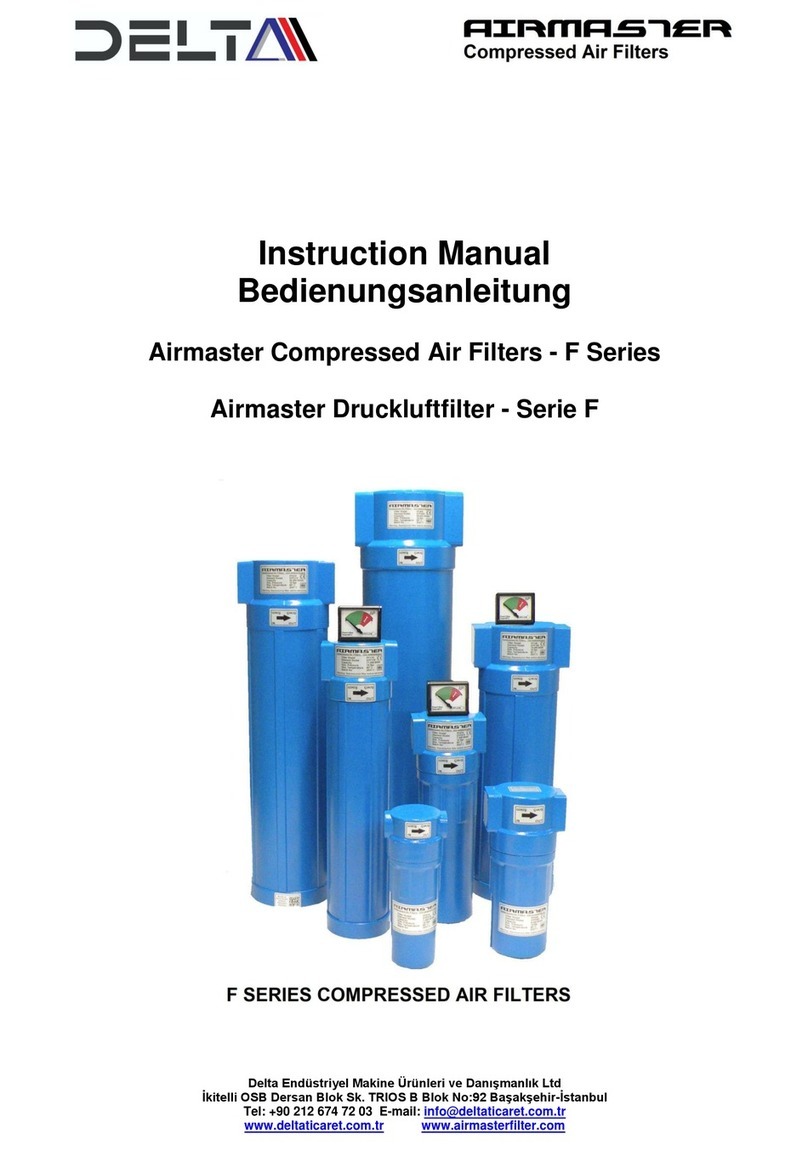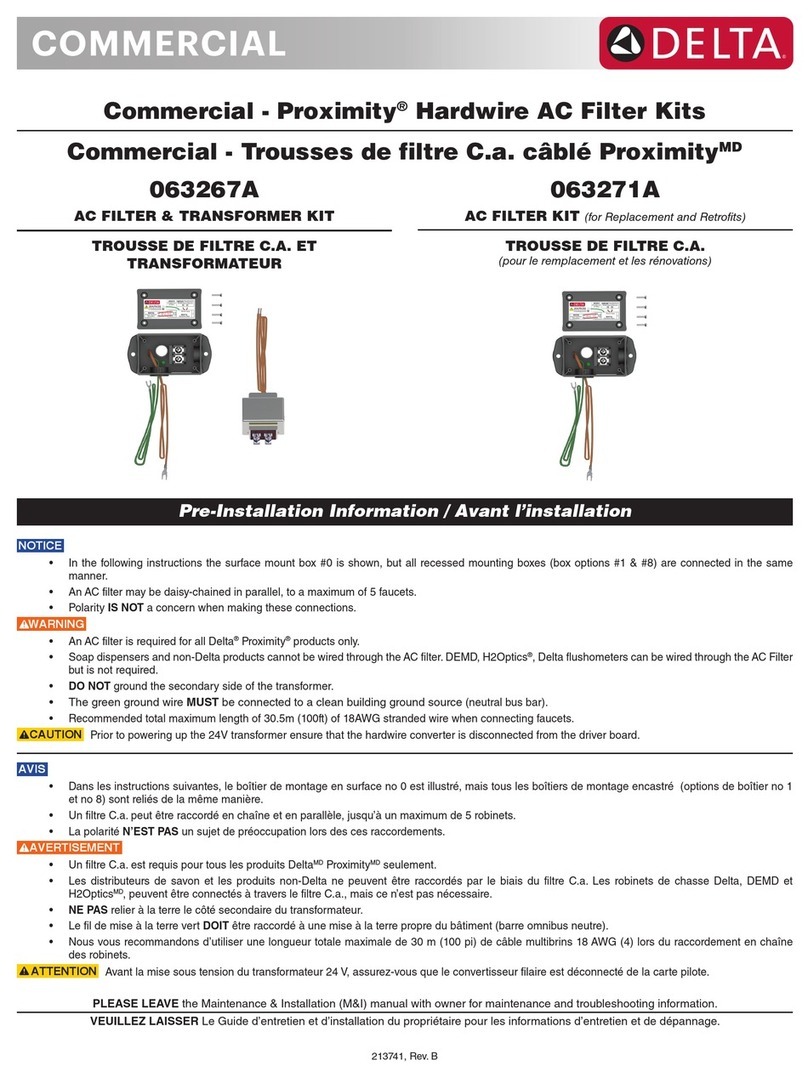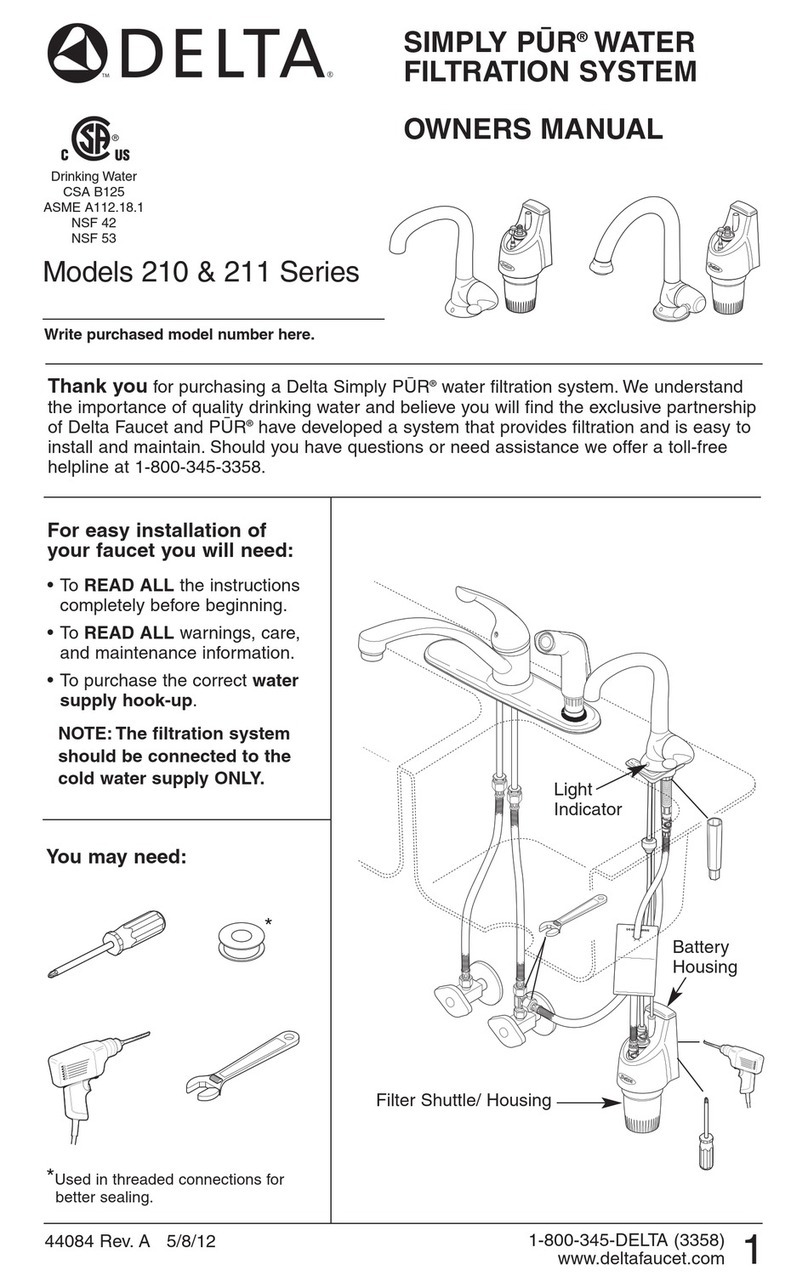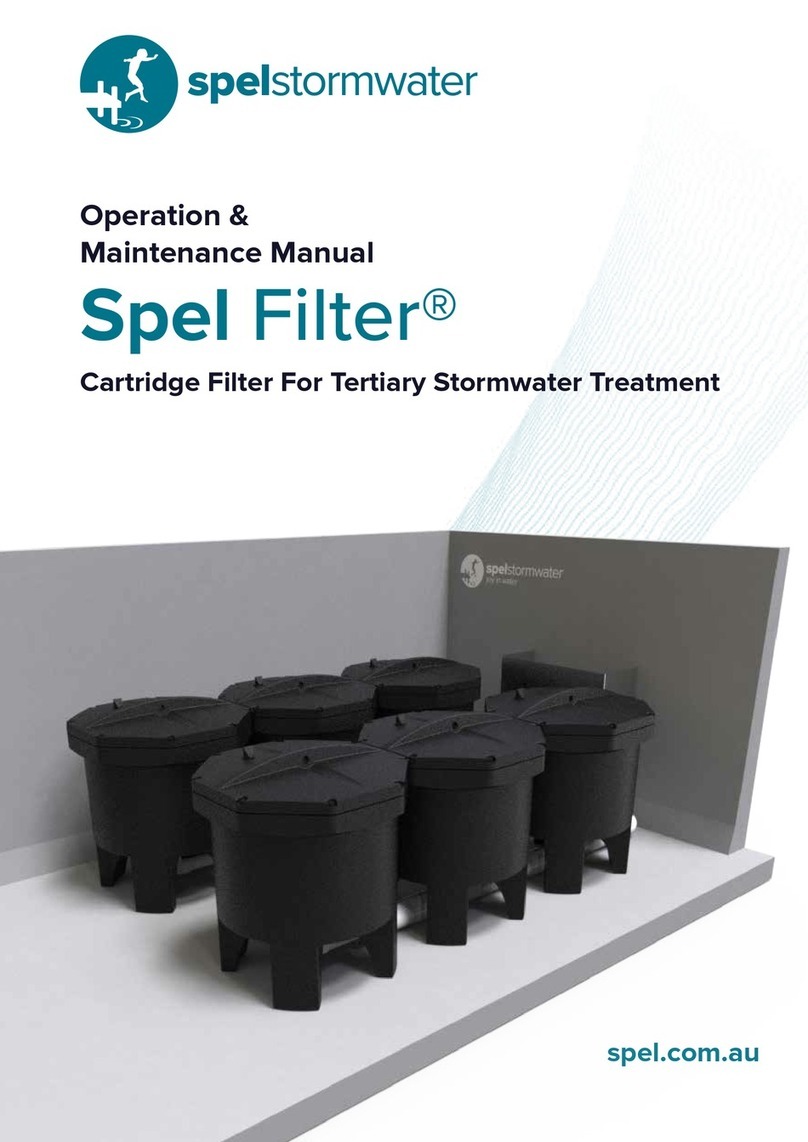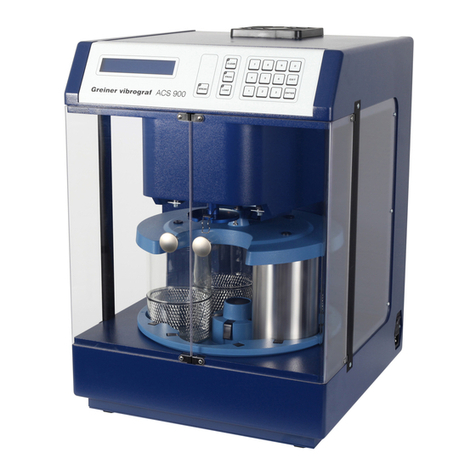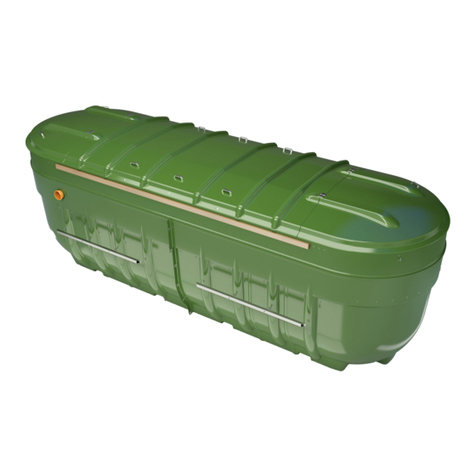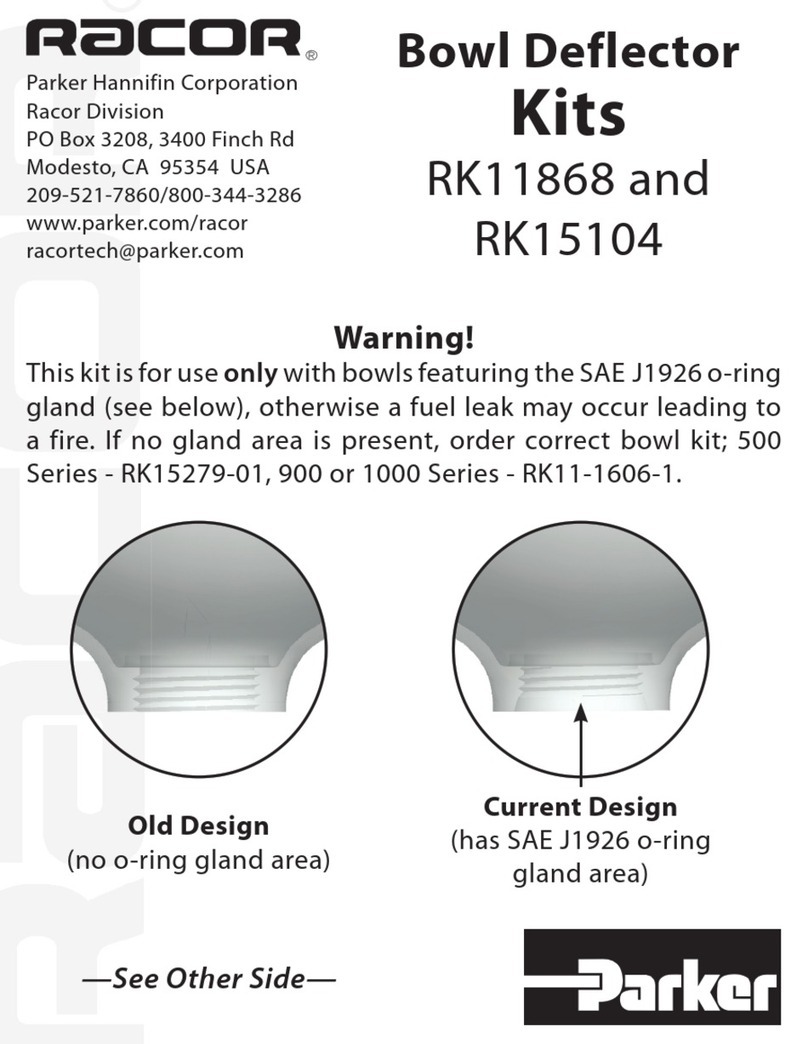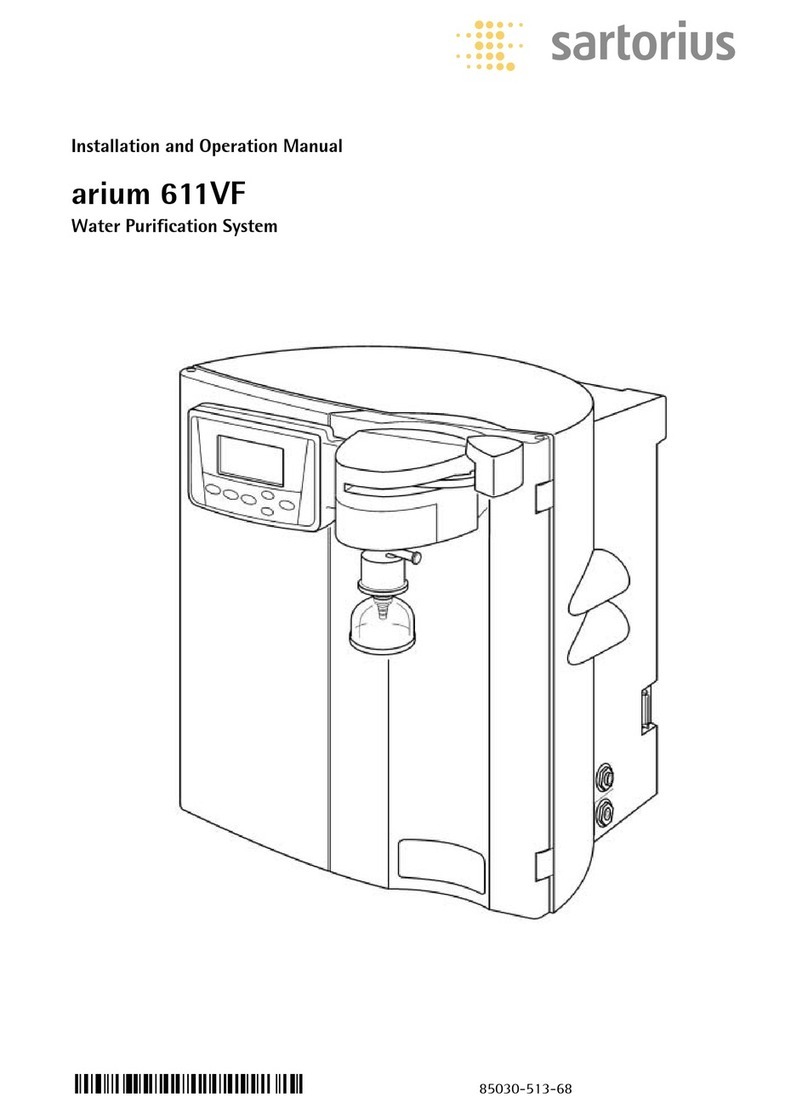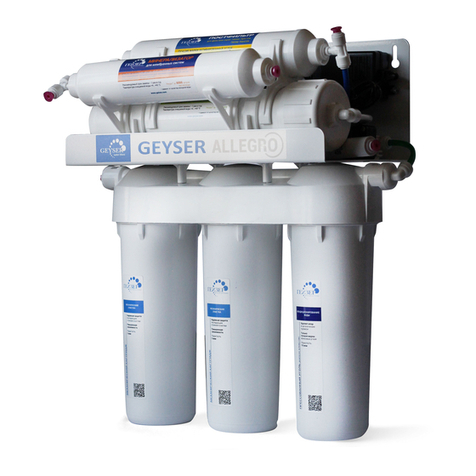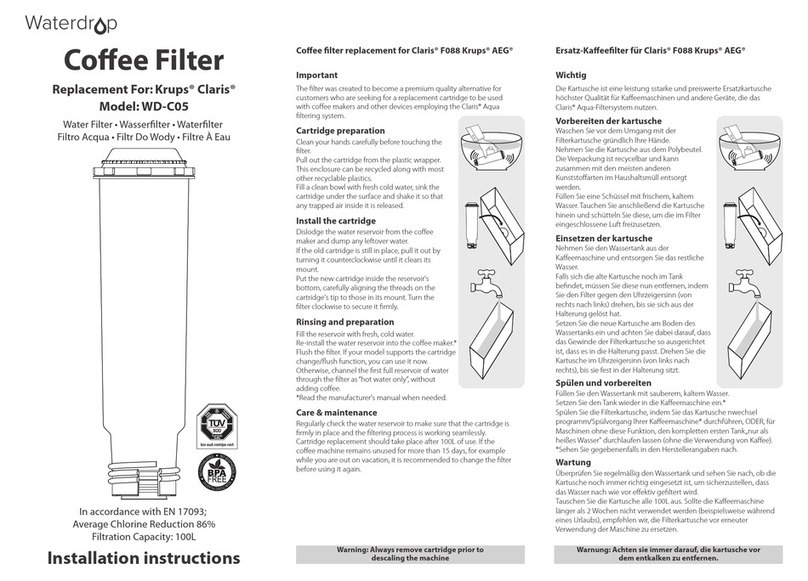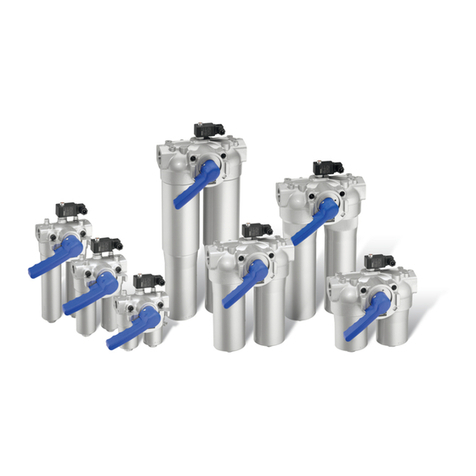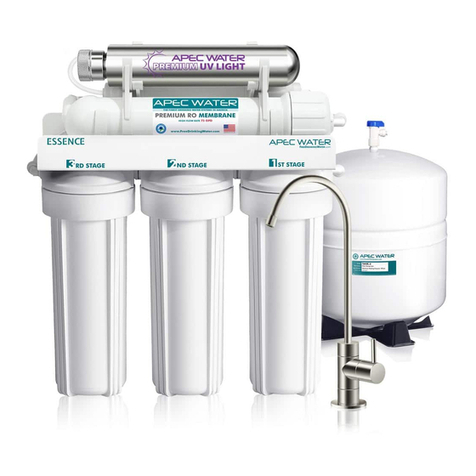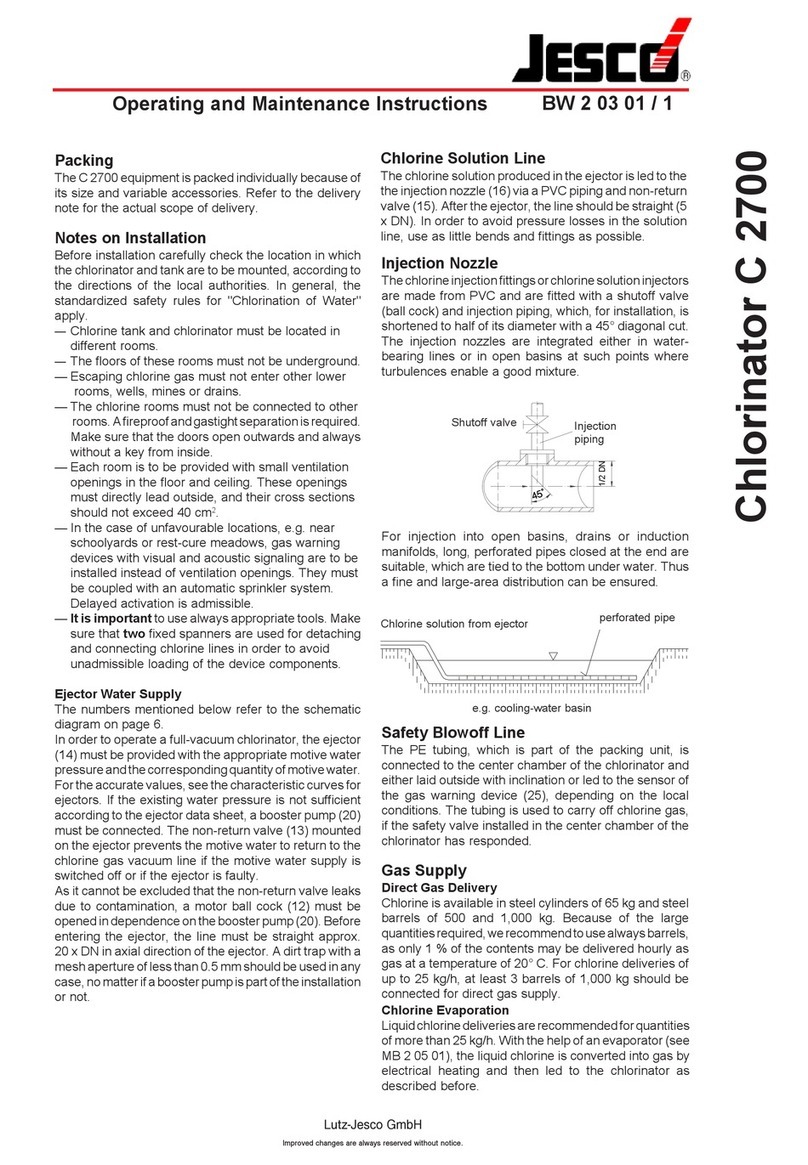Delta Ecodrip Series User manual

Care and Operation Manual
9125 Comar Drive, Walker, LA 70785
(800) 219-9183
K4514 4/18 ©2018Delta Treatment Systems, LLC
ECODRIP SERIES
FILTER/DRIP SYSTEM
MODELS 8115 & 8230

2
DISTRIBUTOR AND HOMEOWNER NOTES
The Delta Treatment Systems' ECODRIP Filter/Drip System is designed to filter effluent water discharged from an aerobic treatment plant
that is listed by the National Sanitation Foundation (NSF) in accordance with NSF/ANSI Standards 40 or 245, Class 1 effluent
requirements. All of the Delta Treatment Systems aerobic treatment plants are listed by NSF in accordance with ANSI/NSF Standard 40
at a minimum, Class 1 and make a perfect combination when used with the ECODRIP Filter/Drip System and drip line designed for Class
1 effluent water.
Consult your local Sanitarian/Environmentalist prior to installation.
HOMEOWNER RECORDS
S/N: __________________________________________ Date:________________________
Installed By: __________________________________________________________________
Distributor: ___________________________________________________________________
Actual Timer Setting: On for ___ minutes off ____ hours.
Flow through meter at time of installation: _______GPM.
Timer DOES NOT need to be reset after power outage.
(PLC can be field adjusted for run time)

3
CARE AND OPERATION INSTRUCTIONS
The ECODRIP System has been designed and built to provide
long term, reliable and efficient service. Once the unit has been
installed (see installation instructions) the unit will operate with
a minimum amount of attention. The following checks should be
made periodically as described:
CAUTION: USE LATEX PROTECTIVE GLOVES WHEN HANDLING
EFFLUENT WASTEWATER. AVOID GETTING ANY EFFLUENT WATER
ON YOU. WASH UP WITH ANTI-BACTERIAL SOAP WHEN FINISHED.
Daily: – Owner/Operator
Check the alarms on both the treatment plant and dosing system.
The treatment plant alarm comes on when the air supply system
has malfunctioned. If the alarm is activated, check for a blown
fuse or thrown circuit breaker. Check air compressor to be sure
it is operating. Once accustomed to the soft humming sound
of a properly operating unit, any unusual noise is an indication
of malfunction. If an unusual noise is detected or total failure is
observed, call your local dealer for service.
Weekly: – Owner/Operator
Check the treatment plant for offensive odor.
Check for water leakage at the ground level boxes that house the
components of the filter system.
If such conditions should develop, call your local dealer for service.
6 Months: – Dealer Service
Check the air filter on the air compressor. Rinse with warm water
if necessary.
Check the screen filter in the filter system. Rinse with clean water
if necessary.
Periodically: – Solids Removal
(Refer to the Treatment Plant Maintenance Manual)
DURING THIS PROCEDURE IT IS IMPORTANT THAT CARE IS TAKEN
TO PREVENT ANY SOLIDS FROM DISCHARGING INTO THE DOSING
TANK.
During pump out of treatment plant, pump out the lower 25
percent of the dosing tank to remove any solids that would have
accumulated on the bottom.
Any sludge removed from system must be disposed of according
to all state, local, and federal regulatory requirements.
The alarm to the dosing tank is activated when there is a high
water situation in the dosing tank. This could indicate a problem
with the filter system, dosing pump, or pump float level switches.
Observe if dosing pump is operational. Turn the Hand-Off-Auto
switch located in the control panel to the hand position. This will
override the PLC timer and turn the pump on if operational. There
is a 2 minute delay after power up before pump start. Observe
the water meter located in the filter box for flow. If the flow is less
than that at the time of installation, it is possible the filter requires
cleaning. Disconnect power from the filter control panel. The
filter is located in the filter box. Unscrew the filter canisters and
remove the screen element in the filter housing. Wash filter screen
with clean water and reinstall into the canister. Turn the switch
to the hand position and observe the water meter, again there is
a 2 minute time delay before pump run. Flow would have been
reduced if the filter were excessively dirty. After a period of time,
observe if alarm stops sounding. This will indicate whether or not
the system has returned to normal operation. Turn the switch
back to the automatic position.
One revolution of the water meter is 10 gallons.
If no flow has been observed, call your local dealer for service.
CAUTION: EXCESSIVE MANUAL OVERRIDE MAY CAUSE WATER
TO SURFACE AT THE GRID SYSTEM. MANUAL OVERRIDE MUST NOT
EXCEED 10 MINUTES EVERY 2 HOURS.
Note:
To keep maintenance to a minimum and ensure high effluent
quality, the following items should not be permitted to enter the
system:
• Strongdisinfectantsorbleaches,otherthansmallamounts
normally utilized in day to day cleaning and laundry (be
conservative). Use low-sudsing, low phosphates and
biodegradable laundry detergents.
• Dischargefromwatersoftener
• Anytypeofoils,greases,orotherchemicalwastes
• Disposablebabydiapersandwipes
• Sanitarynapkins,condomsorothersimilardevices
• Hair,bandages,rags,orstring
• Latex,plastic,ormetallicobjects
• Coffeegroundsorcigarettebutts
• Mudorsticks
• Papertowels,napkinsorKleenex
• Excessiveuseofwateroverthedesignowofthesystem,
or organic overloading in excess of design parameters
• Theproperoperationofthisoranyotherhomesewage
system depends upon proper organic loading and the
life of the microorganisms inside the system. Delta is not
responsible for the in-field operation of the system, other
than the mechanical and structural workings of the system
itself. We cannot control the amount of harsh chemicals or
other harmful substances that may be discharged into the
system by the occupants of a household.
HOW THE ECODRIP FILTER SYSTEM
WORKS
The ECODRIP Filter/Drip System consists of the following basic
items:
1. Secondary Wastewater Treatment System
2. Dose Tank per State Requirements
3. High Head Turbine Pump
4. ECODRIP Filter Headworks System
5. Valves
6. PLC Controls and Alarm Panel
7. Subsurface Drip Tubing and Accessories per Table 1
Treated effluent water from the secondary wastewater treatment
system spills into an underground dose tank that is sized in
accordance with State requirements. Treated water is temporally
stored in the dose tank until disposal in the drip disposal field.
The control panel contains a programmable logic controller (PLC)
that periodically turns the pump, located inside the dose tank, on
and off. The pump moves water from the dose tank to the filter
located inside a ground level box. The filter removes all particles
greater than 100 microns (150 mesh) in size. At the beginning of
each pumping cycle, the PLC turns the pump on, and sequentially
opens and closes the flush valve that allows the filter to wash for a
set period of time, after which the water is pumped through the
(continued on next page)
n
n

4
filter to the disposal system. Approximately once per week
(field adjustable), the system field flush valve opens to flush
the disposal system of any solids that have built up. Sequential
flushing is done for each zone during subsequent pump cycles.
The flush water along with any impurities removed by the filter is
returned to the wastewater treatment plant for further treatment.
The control panel is furnished with a Hand-Off-Auto switch
located in the panel. The hand mode overrides the PLC timer so
the pump can be manually turned on. When the level of water
in the dosing tank is low, the pump float switch will be in the off
position, disabling the pump. The control panel also contains a
high level alarm that will sound if a high level is reached in the
dose tank which may indicate a system malfunction.
The filtered effluent is pumped through the supply line to flexible
polyethylene tubing with large turbulent flow labyrinth or pressure
compensating emitters uniformly spaced along the line. Effluent
is uniformly distributed over the entire absorption field using a low
flow rate.
Absorption field size is determined by, soil type, site
characteristics and daily wastewater flow. The field size varies
depending on soil texture and permeability. The absorption field
should be situated on the best soil and landscape position of the
site. Separation between the bottom of the emitter pipe and any
underlying restrictive horizons (seasonably high water table) can
be as little as 6 inches or as regulations require. The emitter lines
should be installed between 6 and 18 inches deep depending on
soil and site characteristics.
An absorption field installed on slopes should be carefully
designed to take into consideration elevation changes and emitter
line placement due to gravitational pressures. The treatment plant,
dosing tank and filter unit should not be placed in low areas in
order to prevent subsurface or surface runoff from returning or
flooding the units.
Once the soil and site evaluation has been completed, the most
suitable location and size of the absorption field is selected.
Depending on the hydraulic loading rate of the soil, the linear feet
of emitter pipe and number of zones are determined. It is also
important that each zone is placed along the ground contour. The
configuration of the zones may vary in shape.
The PLC controller must be set in the field as system flow and the
number of zones will vary from site to site. The pump run time is
factory set, but can be changed in the field.
The number of pump cycles is factory set at 12 per day (field
adjustable).
Example Using Geoflow®Classic Tubing:
System flow – 600 gallons per day (GPD)
Total length of emitter pipe – 1260 feet
Number of zones - 2 at 630 feet each
Number of pump cycles – 12 (factory set)
Zone capacity – 6.4 gallons per minute (GPM)
Number of gallons pumped per pump cycle =
600 GPD = 50 gallons per pump cycle
12 pump cycles per day
Run Time = 50 gallons per pump cycle = 7.81 minutes
6.4 GPM
Using a safety factor of 1.5, set time at 1.5 x 7.81 = 12 min.
Pre-Engineered Subsurface Drip Disposal
Systems by Delta Treatment Systems
TABLE 1
8115-1/ 2 HP
8230-1 HP
Note: Each system is designed to be hydraulically balanced with a maximum 300 feet of supply line between the pump and the inlet to the drip field with a maximum elevation difference of 30 feet.
Consult Delta Treatment Systems for alternate designs.
Drip Tubing Drip Tube
per Zone
Laterals
per Zone
Length
per Lateral
Max. Number of
Zones per System
Pressure
Regulator
Zone Discharge
in GPM
Geoflow®Classic 630 3 210 6 20 PSI 6.4
Geoflow®PC .53 1,320 6 220 6 20 PSI 5.8
Geoflow®PC 1.01 750 3 250 6 20 PSI 6.3
Netafim Bio-Line PC .61 1,200 3 400 6 20 PSI 6
Drip Tubing Drip Tube
per Zone
Laterals
per Zone
Length
per Lateral
Max. Number of
Zones per System
Pressure
Regulator
Zone Discharge
in GPM
Geoflow®Classic 1,500 7 215 6 20 PSI 15.3
Geoflow®PC .53 2,400 8 300 6 40 10.6
Geoflow®PC 1.01 1,750 6 250 6 40 PSI 14.6
Netafim Bio-Line PC .61 2.100 7 300 6 40 PSI 10.7

5
DRIP SYSTEM DESIGN
Project : _________________________________ Date: ____________________________________
Owner: __________________________________ Phone: ___________________________________
Location: ________________________________ County: __________________________________
Soil type: ________________________________ Soil Texture: _______________________________
Soil Group: _______________________________ Depth for Optimum Use: ______________________
Soil Loading Rate: __________________________ Projected Daily Flow: _________________________
Disposal Area Size __________ GPD ÷ __________ Loading Rate = _________ Sq. Ft.
Total Drip Line (2' Lateral Space) _________ Sq Ft ÷ 2 = __________ L/Ft
Example using Geoflow®Classic Drip Tubing:
Maximum Drip Line Per Zone 630 Linear Feet – 8115-1/2 HP, 115 Volt Pump
Maximum Drip Line Per Zone 1500 Linear Feet – 8230-1 HP, 230 Volt Pump
Emitter Flow Rate 1.22 GPH Nominal
Dosing Pump Capacity 6.4 GPM – 8115-1/2 HP, 115 Volt Pump
Dosing Pump Capacity 15.25 GPM – 8230-1 HP, 230 Volt Pump
________________ L/Ft (drip line required) ÷ 630 (max. per zone) = _______________ # zones
1/2 HP
________________ L/Ft (drip line required) ÷ 1500 (max. per zone) = _______________ # zones
1 HP
*Round up to the next whole number; if more than one zone they should be equal. Maximum 4 zones.
Site Slope _________% When slopes of 20% or greater are encountered use three (3) ft.
minimum lateral spacing
Refer to Drip Tubing Chart (Table 1) in this manual for standard Drip Tubing
zones, Consult Delta Treatment Systems for optional zone sizing.

6
SIZE OF THE ABSORPTION FIELD
The total size of the absorption area depends on the daily
wastewater flow and the absorption capability of the soil.
1. Determine the estimated daily flow. The local health depart-
ment will have guidelines for determining residential flows.
2. Determine the loading rate of the soil. The local health
department will have guidelines for loading rate per soil con-
ditions. Qualified persons should conduct soil and site
evaluations only. After evaluation of the soil, the hydraulic
loading rate is established using the appropriate table (USDA
soil classes or State approved tables).
3. Calculate the total area necessary for the absorption field with
the following equation:
Area = Daily flow
Soil Loading Rate
4. Determine the total length of the emitter line required in the
absorption area. Spacing between laterals is normally 24
inches.
Total Absorption Area in Square Feet = Total Emitter
Emitter Line Spacing Line Required
5. Determined the layout of the emitter line absorption field.
When selecting the layout of the field, always place the
emitters along the contours of the ground area, keeping the
emitter line lateral runs as close to the same grade as pos-
sible. When running a continuous emitter line that requires
a loop, make a connection to solid flex pipe to prevent the
emitter line from kinking.
6. The ECODRIP 8115-1/2HP drip system is capable of zone
sizes as indicated on Table 1. Using two or more zones keeps
the pump HP to a minimum.
The ECODRIP 8230-1HP drip system is capable of zone sizes
as indicated on Table 1. Using two or more zones keeps the
pump HP to a minimum.
7. The ECODRIP 8115-1/2 HP drip system utilizes a 1/2 HP
dosing pump. The ECODRIP 8 8230-1HP drip system utilizes
a 1HP-dosing pump.
8. A pressure regulator is furnished and should be installed at
the drip grid supply header at each zone. The pressure regu-
lator will provide proper pressure to the emitters.
9. The requirement of flushing the emitter lines, using the
8115-1/2HP, is important so that proper velocities be main-
tained through the entire system. The supply line from the fil-
ter unit to the emitter supply manifold should be as indicated
on drawings to reduce the friction loss to a minimum and
keep the velocity above 2 feet per second. Each zone must
not have more than indicated on Table 1. This will ensure
that each lateral will receive a minimum of 1.69 gallons per
minute during a flush cycle. The return line is also an integral
part of the system and must be sized for minimum friction
loss and velocities above 2' feet per second.
The requirement of flushing the emitter lines, using the
8230-1HP, is important that proper velocities be maintained
through the entire system. The supply line from the filter unit
to the emitter supply manifold should be as indicated on
drawing to reduce the friction loss to a minimum and keep
the velocity above 2 feet per second. Each zone must not
have more than indicated on Table 1. This will ensure that
each lateral will receive a minimum of 1.69 gallons per
minute during a flush cycle. The return line is also an integral
part of the system and must be sized for minimum friction
loss and velocities above 2' per second.
10. A hydraulic zoning valve is typically furnished to automate the
switching of zones. The simplicity of design and a minimum
number of moving parts ensure ease of maintenance and a
long service life. The four-outlet model has interchangeable
cams for 2, 3, or 4 zone operation. It is important that each
zone be of equal size. An absorption field with more than one
zone will be dosed equally. The flushing cycle for multiple
zones will be in sequential pump starts to ensure that each
zone is flushed. Check valves are required to isolate each
zone in a multiple zone system.
11. Solenoid valves can be used to automate the switching of
zones and allow for different dosing times of each zone.
Contact factory for details.
The instantaneous water application rate of the system must not
exceed the water absorption capacity of the soil. A determination
of the instantaneous water absorption capacity of the soil is
difficult; it varies with the water content of the soil. As the soil
approaches saturation with water, the absorption rate reduces to
an equilibrium rate called the "saturated hydraulic conductivity."
Long-Term Soil Textural Classes Long-Term Acceptance Rate
Soil Group (USDA Classifications) GPD/ft2
I Sands (with S or PS
structure & clay mineralogy)
0.4
II Coarse Loams, Sandy Loam
(with S or PS Loam structure
& clay mineralogy)
0.3
III Fine Loams, Sandy Clay
Loam (with S or PS structure
& clay mineralogy)
0.15
IV Clays, Sandy Clay
(with S or PS structure
& clay mineralogy)
0.1 – 0.05
Absorption Field Required per 100 Gallons of Wastewater
Loading Rate Square Feet Linear Feet
0.4 250 125
0.3 333 167
0.15 666 333
0.1 1000 500
0.05 2000 1000

7
FILTER SYSTEM SPECIFICATIONS
MODEL 8115-1/2HP WITH GEOFLOW®CLASSIC
Operating Perameters
Motor/pump size 1/2 HP (standard)
Pressure at outlet of regulator 20-PSI nominal
Maximum particle size 100 microns
Pump cycles 12 times per day
(factory setting)
Electrical requirements 115V/1/60 - 20 amps
Components and Materials
Pump/motor Stainless steel submersible
Piping system Schedule 40 PVC
Valves Glass reinforced nylon
Pressure regulator Thermoplastic with stainless
steel hardware
Control panel Nema 4X Fiberglass
Solenoid valves Encapsulated 24 Vac
Filter 150-mesh stainless steel
screen
Dripline 1/2" plastic tubing with
nominal 1 GPH turbulent
non-compensating emitters
Parts List
Item Item No.
Dose tank 1
Pump/motor 2
Low level alarm float (normally closed) (optional) 3
Pump on/off permissive float switch 4
Override timer reset float switch 5
Override timer float switch 6
High level alarm float switch 7
Vacuum release valve 8
Rectangular filter system box 9
Filter 10
Filter flush valve 11
Flow meter (optional) 12
Field flush valve 13
Pump access riser 14
Control panel 15
MODEL 8230-1HP WITH GEOFLOW®CLASSIC
Operating Perameters
Motor/pump size 1 HP (standard)
Pressure at outlet of regulator 20-PSI nominal
Maximum particle size 100 microns
Pump cycles 12 times per day
(factory setting)
Electrical requirements 230V/1/60 - 20 amps
Components and Materials
Pump/motor Stainless steel submersible
Piping system Schedule 40 PVC
Valves Glass reinforced nylon
Pressure regulator Thermoplastic with stainless
steel hardware
Control panel Nema 4X Fiberglass
Solenoid valves Encapsulated 24 Vac
Filter 150-mesh screen with
thermoplastic housing
Dripline 1/2" plastic tubing with
nominal 1 GPH turbulent
non-compensating emitters
Parts List
Item Item No.
Dose tank 1
Pump/motor 2
Low level alarm float (normally closed) (optional) 3
Pump on/off permissive float switch 4
Override timer reset float switch 5
Override timer float switch 6
High level alarm float switch 7
Vacuum release valve 8
Rectangular filter system box 9
Filter 10
Filter flush valve 11
Flow meter (optional) 12
Field flush valve 13
Pump access riser 14
Control panel 15

8
INSTALLATION INSTRUCTIONS
1. Prepare an excavation with an opening approximately one
foot larger than the dose tank and a depth that will allow
water to freely flow from the treatment plant into the dose
tank. Backfill with a 6 inch layer of sand or gravel if otherwise
unable to provide a smooth, level, compact base. Install the
pump access pipe into the dose tank through the top of the
tank and seal. Provide a sufficient length of pipe to extend
into the pump access riser about 4 inches. We recommend
that the hole be roped off in some fashion to prevent injury to
passers by.
2. Fill the dose tank with clean water before back filling. Backfill
around the tank approximately 12 inches below ground level.
Backfill material should be placed in 12 inch layers and
tamped to insure maximum skin friction between dose tank
and surrounding ground.
3. Position the electrical conduit in the ground between the
pump access riser and the filter box. Drill a 1- 3/4" hole in the
pump access riser for the pump outlet pipe and a 7/8" hole
for the electrical conduit. Install round pump access riser and
rectangular filter system access box so that they are flush
with ground level, and high enough to prevent surface water
from entering them.
4. Install a schedule 40 PVC pipe of sufficient length to extend
from the pump into the round pump access pipe and have
enough room to attach the vacuum release valve and union.
Install the vacuum release valve and union using appropriate
fittings.
5. Attach the float switches to the discharge pipe using clamps
furnished by Delta. Adjust the position of the clamps as
shown on the drawings or as required to insure that the pump
stops at the minimum operating water level and turns on at
about 1'-0" above this level, and that the alarm sounds at
high level position. Set the other floats where shown.
6. Install the entire pump assembly through the pump access
riser. Install the electrical cables and connect the union
from the pump outlet to the filter system. Use silicon to seal
around exiting piping.
7. Connect the filter system outlet pipe to the drip line pressure
regulator that attaches to the supply manifold. Connect the
drip line return manifold to field flush valve, located in the
filter assembly. Connect the outlet of the field flush valve to
the inlet of the treatment system.
8. Attach control panel to suitable mounting surface using all
four mounting holes on back of box. Use proper screws of
sufficient length to insure a secure and permanent mounting.
9. Control panel is rated for outdoor service, however do not
place it where it can be immersed in rising water or where
run-off water such as from a roof will fall on it. Also do not
mount it where it is subject to wetting from sprinklers, hoses,
etc. Mount control panel where there is a minimum working
space 30” wide and 6’ high.
10. The control panel must never be connected to a circuit that is
not properly grounded. Never plug the unit into a receptacle
that has a 2 pole to 3 pole grounding adapter attached. If
there is any doubt, have a qualified electrician check for
proper grounding. The control panel must be connected
to an electric source equipped with a ground fault current
interrupter (GFCI) circuit breaker or GFCI receptacle. A
standard receptacle can be replaced with a GFCI receptacle.
GFCI breakers and receptacles can be obtained from most
stores that sell electrical supplies.
11. The wire from the filter system to the control panel if direct
buried MUST BE TYPE UF rated for underground service.
It must be buried a minimum of 2 feet below the final grade
and must be protected by conduit where it exits the ground
as shown on installation drawings. Conduit must extend a
minimum of 1'-6" below ground where the wires rise from
the ground to the control panel. These requirements are per
the National Electric Code. Check with local authorities to
see if they have more stringent requirements. Schedule 40
PVC is shown, note this is conduit not water pipe. However,
if the conduit is subject to physical damage, you must use
schedule 80 PVC conduit and appropriate fittings.
12. Wire the solenoid valves as shown on the drawings.
13. Verify that all electrical systems are connected and secure.
14. Close cover on control panel and connect control panel to a
ground fault current interrupter (GFCI) circuit.
15. Verify proper pump operation by observing pump while
manually operating pump float switch. Pump must not be run
unless immersed in water. Verify alarm system by manually
operating alarm float switch. Pump and dispose of all clean
water in the tank. Verify that 1'-2" of water remains inside
the tank when pump stop float switch turns pump off. Verify
operation of the floats by observing PLC input screen.
16. Install a 2-inch layer of gravel in the access boxes and
complete back filling the site.
17. Install drip line 6 to 8 inches deep, but not to exceed 18"
below ground. The drip line should not be stretched during
installation or damage may occur.
18. Install the system header first: Typical layout will be Filter
Unit, Zone Valve (if required) and pressure regulator at each
individual Drip Zone. Then install the PVC schedule 40 supply
lines. These should be buried at a depth of 12 to 18 inches,
4 to 12" below the depth of the WASTEFLOW®lines. If there
is a risk of freezing, bury mainlines below the frost line. At all
times avoid getting debris into the system. Flush main lines,
test for leaks and leave them full of water. Larger diameter
pipes left full of air in a trench that has not been compacted
may "float". System must be installed per drip line layout
drawings.
19. Open trenches for the sub-main manifold and flush line
manifold. These trenches should be 8 to 10 inches deep. At
the beginning of the drip line trench construct an earth damp
above drip line elevation and lay drip line over earth damp to
manifold. This will prevent water from draining from drip line.
20. Clean sub-main and flush line manifold trenches, moisten
and compact the bottom of the trench. (If this is not done,
the manifolds may "settle down" and slowly pull out the
couplings). Assemble the submain manifold outside the
trench if practical. Connect to main PVC lines and to the
system header. Flush these lines. A high water velocity is
required to carry away debris that may have entered the
pipes before or during installation. Place the sub-main and
flush manifolds into the trench.
21. Install drip lines on contour, not perpendicular or up and
down, etc. to the slope. No two drip laterals in the same zone
should have more than an 8 feet elevation difference, when
using Goeflow Classic.

9
22. Maximum lateral length, for standard zones are as indicated
in Table 1, consult Delta Treatment Systems for alternative
zones.
23. Minimum lateral spacing must be 2 feet, except for special
design.
24. Lateral spacing of three feet or more should be used for
slopes of 20% or greater.
25. Install air vent/vacuum breakers at the high end of each drip
zone supply and return manifold. Air vents/vacuum breakers
to be placed in protective enclosure to prevent an
accumulation of substances that could prevent their proper
operation and they must have a grade level access
26. The size of the installation, type of soil, slope, availability of
labor and cost will determine the best installation method.
During installation cover all open pipe ends including drip
lines to avoid getting dirt or debris into the system. Leave
enough length at the beginning and end of each drip line
for connections. It may be more convenient to finish the last
foot or so of the trench by hand. This gives more room for
connections. Beware of bending the drip tubing too tight
during installation. Do not bend tubing at the 24" radius loops
or the pipe may kink, reducing the flow. Use 1/2" flexible PVC
pipe and fittings to loop emitter pipe. The drip line will
elongate at high temperatures, do not store in direct sunlight.
To prevent stress due to contraction always leave tube snaked
from side to side of trench (1' per 100') or when plowing
leave slack at supply and return manifold. Connect drip
lines to sub-main and flush manifolds. Flush again. Run the
system before covering and check for leaks.
27. Install schedule 40 PVC for return flush line. Run return
line back to the filter system. The electric solenoid valve
that operates the flush line is part of the filter system. Install
schedule 40 PVC drip flush line and filter flush line back to
the treatment plant as shown on the drawings.
28. To over come the lack of depth to a restrictive horizon and/or
seasonal water table a clean fill material of loamy sand, sandy
loam or light loam may be used as fill. The fill material shall
consist of a minimum of 70% sand particles equal to or
greater than 0.25 mm. Clay content shall be 20% or less.
Organic matter should be removed prior to placing fill material.
If not the site must be plowed to prevent an organic sealing
layer from forming. Fill material should be applied over the
entire area in a shallow layer (3 inches) and then be tilled into
the natural soil to prevent a textural interface from forming.
When fill is used, the entire area must be covered with sod to
prevent erosion or other erosion control measures taken.
29. Whenever possible, spend time with your customer. Review
operation instructions. Be sure that the customer has a
manual to keep with them, this may avoid an unnecessary
return visit.
DELTATREATMENT SYSTEMS
FILTER SERVICE POLICY
INITIAL POLICY:
The manufacturer or the distributor through the dealer shall furnish a two-year initial service policy tothe user. This policy is
included in the original purchase price and shall provide the following:
1. An inspection/service call every six months, which includes inspection, adjustment, and servicing of the mechanical
and electrical component parts as necessary to ensure proper function.
2. If any improper operation is observed which cannot be corrected at that time, the user shall be notified immediately in
writing of the conditions and the estimated date of correction.
CONTINUING SERVICE POLICY:
An annually renewable service policy affording the same coverage as the Initial Service Policy is available. Consult your
dealer for pricing information.
PARTS:
Replacement parts or components may be obtained from your local distributor or directly from Delta Treatment Systems.
COMPLAINTS:
In order for Delta Treatment Systems to properly address any complaints we require that you put in writing the date and
nature of the complaint as detailed as possible. This must include the serial number of your system.
Send to:Delta Treatment Systems
9125 Comar Drive
Walker, LA 70785

10
CAPACITY OF ROUND TANKS
Per Foot of Depth
Volume in gallons per foot of a Round Tank = Radius Square x 3.142 x 7.48 gallons per cubic foot.
CAPACITY OF SQUARE OR RECTANGLE TANKS
Per Foot of Depth
Volume in gallons per foot of a Square or Rectangular Tank = Length x Width x 7.48 gallons per cubic foot.
PERCOLATION – HYDRAULIC CHART
The above table is provided as a guide only, you must follow all local, county and state code requirements.
Diameter Gallons Area Sq. Ft. Diameter Gallons Area Sq. Ft.
2' 23.50 3.14 6' 211.51 28.27
2' 6" 36.72 4.909 6' 6" 248.23 35.18
3' 52.88 7.069 7' 287.88 38.48
3' 6" 71.97 9.621 7' 6" 330.48 44.18
4' 94.00 12.566 8' 376.01 50.27
4' 6" 118.97 15.90 8' 6" 424.51 56.75
Length & Width Gallons Area Sq. Ft. Length & Width Gallons Area Sq. Ft.
4' x 4' 119.68 16 9' x 9' 605.88 81
5' x 5' 187.00 25 10' x 10' 748.08 100
6' x 6' 269.28 36 11' x 11' 905.08 121
7' x 7' 366.52 49 12' x 12' 1077.12 144
8' x 8' 478.72 64 14' x 14' 1466.08 196
Soil Type Percolation Rate
Min./In.
Hydraulic Conductivity
In./Hour
Hydraulic Loading
Gal./Day/Ft.2
Area Required
Ft.2/100Gal/Day
Coarse Sand <5 >2 2.0 52
Fine Sand 5 – 10 1.5 – 2 1.6 65
Sandy Loam 10 – 20 1.0 – 1.5 1.3 80
Loam 20 – 30 0.75 – 1.0 0.9 115
Clay Loam 30 – 45 0.5 – 0.75 0.6 175
Silty Clay Loam 45 – 60 0.3 – 0.5 0.4 260
Clay, Non-Swell 60 – 90 0.2 – 0.3 0.2 520
Clay, Swell 90 – 120 0.1 – 0.2 0.1 1040
Clay, Poor >120 >0.1 0.075 1380

11
GENERAL DESCRIPTION OF
OPERATION
1. Upon power up at panel there is a 2 minute time delay before
the pump starts.
2. After this time delay, the pump will start and run for a set
period of time, then turn off for another set period of time.
3. When the pump starts, the filter flush valve will open for a set
period of time then close.
4. After a set number of pump starts, the field flush valve will
open for a set period of time after the pump starts and after
the filter flush valve closes.
5. The field flush cycle will repeat itself on each subsequent
pump cycle for the number of fields connected to the system
before resetting.
6. In a normal cycle, the field flush valve can be opened for
a period of 60 seconds by momentarily pushing the “Field
Flush” toggle switch up then releasing it. This can be re-
peated for additional flushes.
7. At the end of each pumping cycle, after the pump shuts off,
both the filter flush and field flush valves will open for a set
period of time then close.
DESCRIPTION OF CONTROL FLOATS
1. Float FS1 is a wide angle float that when up, permits the
pump to run and when down, keeps the pump from running
and pumping dry. Note that by placing the HAND-OFF-AUTO
switch in HAND position, will by-pass all floats and the pump
will pump dry if held in that position long enough. The switch
spring returns to OFF when released. After FS1 activates,
there is a one minute delay before the pump will start if being
called to run before the float activates.
2. Float FS2 is the override timer reset float and FS3 is the
override timer float. These floats operate together. If the water
level reaches FS3 while in an OFF period, the pump will start
and the OFF period time will change to the setting in block
B02. The run time remains as set in B01. The shorter OFF
time will remain until the water level reaches FS2 after which
the OFF time reverts back to the normal B01 setting.
3. Float FS4 is the high level alarm float. When the water level
reaches this float, the high level alarm light illuminates con-
tinuously, and the audible alarm sounds continuously. The
audible alarm can be silenced by the silence switch. When
the high level water level recedes, the alarm will stop.
4. Float FS5 is an optional float that can be installed below FS1
that will cause an alarm at low water level. Low level alarm
operation is identical to the high level alarm operation except
the alarm light will flash and the audible alarm will sound
intermittently.
5. Floats FS2, FS3, FS4 can be low current, normally open.
FS1 must be of the wide angle type.FS5 can be low current,
normally closed.

12
Upon power up the clock screen may not be displayed. The clock
screen is considered the “main” screen and will be the starting
point for all programming.
Locating the clock screen:
Use the “DOWN” key to scroll until the clock screen is shown.
To enter into program mode press “ESC” once. (See Chart 1)
Arrow down to desired selection and press “OK”.
• Tosetclock,arrowdownto“SET” and press “OK”. “CLOCK”
will appear. Press “OK”. “SET CLOCK” will then appear. Press
“OK” again. Use “LEFT” and “RIGHT” arrow keys to maneu-
ver around and the “UP” and “DOWN” keys to change setting.
Once complete press “OK”. To get to parameter screen press
“ESC”. To get to main screen (clock showing) press “ESC”
again.
• Tosetparameters,arrowdownto“SET PARAMETERS” and
press “OK”. Use “UP” and “DOWN” arrow keys to scroll
through blocks. Once desired block is found press “OK”. Use
“LEFT” and “RIGHT” arrow keys to maneuver around and
the “UP" and “DOWN” keys to change the parameter. Once
parameter is set press “OK”. Now you may continue to scroll
the blocks. Once scrolling is complete press “ESC”. To return
to the main screen press “ESC” again.
Setting the PLC
Display
Loading Port
and Cover
Cursor
PLC
|dentification
FRONT VIEW OF PLC
ELECTRICAL COMPONENT INFORMATION & DRAWINGS
Other drip systems and panels are available that have multiple circuit feeds, utilize solenoid field dosing valves and have dual
filters.
Chart 1 – Earlier versions of the PLC required different key
combinations to enter into program mode, with the clock showing,
press the following:
PLC Identification
OBA00 Press “OK” and “LEFT” and “RIGHT” arrow
keys (at the same time)
OBA1 – OBA2 Press “ESC” and “OK” keys (at the same time)
OBA3 – OBA5 Press “ESC” key (once)
Notes:
1) To view inputs, at the main screen (clock showing) press the
“RIGHT” arrow key. To return to main screen press “LEFT”
arrow key.
2) To view outputs, at the main screen (clock showing) press
the “RIGHT” arrow key twice. To return to main screen press
“LEFT” arrow key twice.
3) Earlier versions of the PLC had the inputs, outputs and clock
on the main screen upon power up.

13
Block Description Factory Setting PLC Nomenclature
B01 T = Run time
TL = Off time
12 minutes
2 hours
12:00 m
02:00 h
B02 Off time during override period 1 hour 01:00 h
B03 FIlter flush time after pump turns on 1 minute 01:00 m
B04 Filter drain time after pump turns off 2 minutes 02:00 m
B05 Field flush time normal operation 2 minutes 02:00 m
B06 Field drain time afer pump turns off 2 minutes 02:00 m
B07 Number of fields 4 4
B08 Number of cycles until 1st field flush 84 84
B09 Field flush time when field flush switch
is pressed 1 minute 01:00 m
PLC PARAMETERS
Notes:
Minute settings are in minutes and seconds. For example: 02:00 m
is 2 minutes, 02:10 m is 2 minutes and 10 seconds. Hour settings
are in hours and minutes. For example: 02:00 h is 2 hours and no
minutes, 02:10 h is 2 hours and 10 minutes, and 00:12 h is 12
minutes.
In addition to the settings above, various other parameters can
be viewed as follows:
• Pumpruntimehours
• Pumpstartcounts
• Leveloverridecounts
• Highlevelcounts
• Switchtohandcounts

14
9125 Comar Drive, Walker, TN 70785

15
9125 Comar Drive, Walker, TN 70785

16
9125 Comar Drive, Walker, TN 70785

17

18

19

20
This manual suits for next models
4
Table of contents
Other Delta Water Filtration System manuals
Popular Water Filtration System manuals by other brands
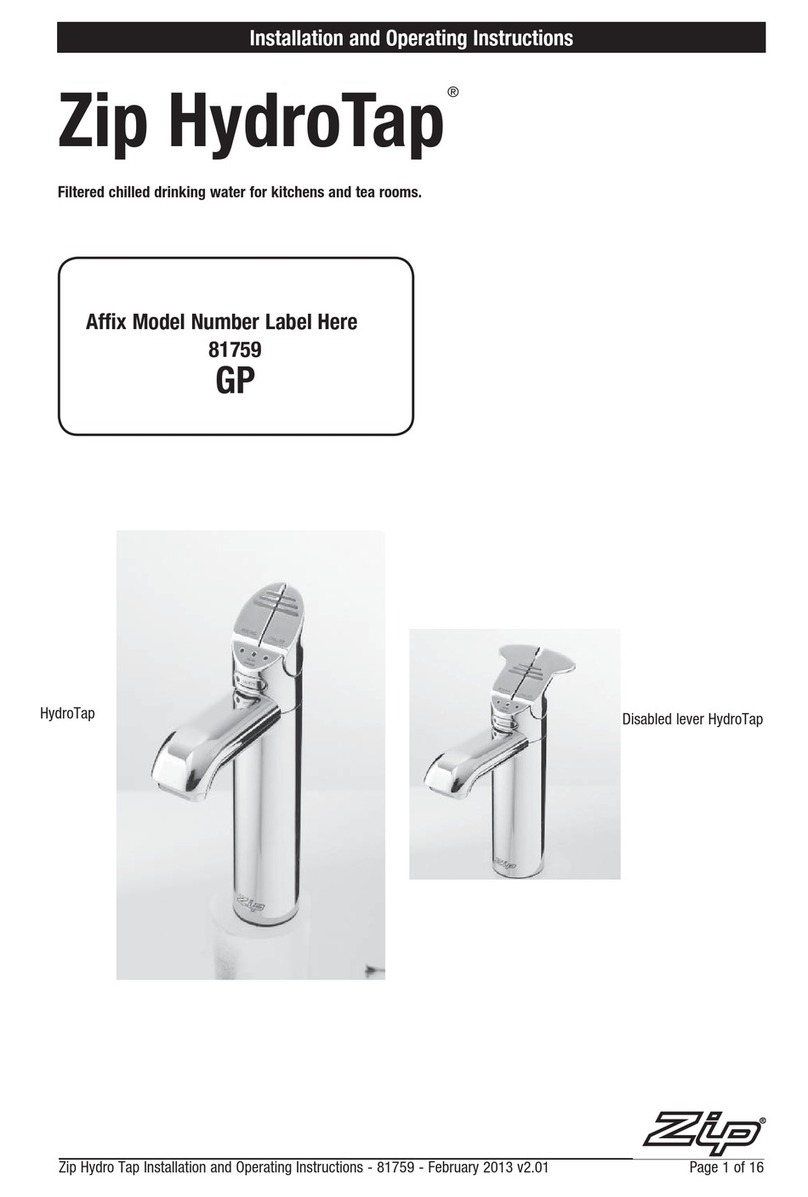
Zip
Zip HydroTap series Installation & operating instruction
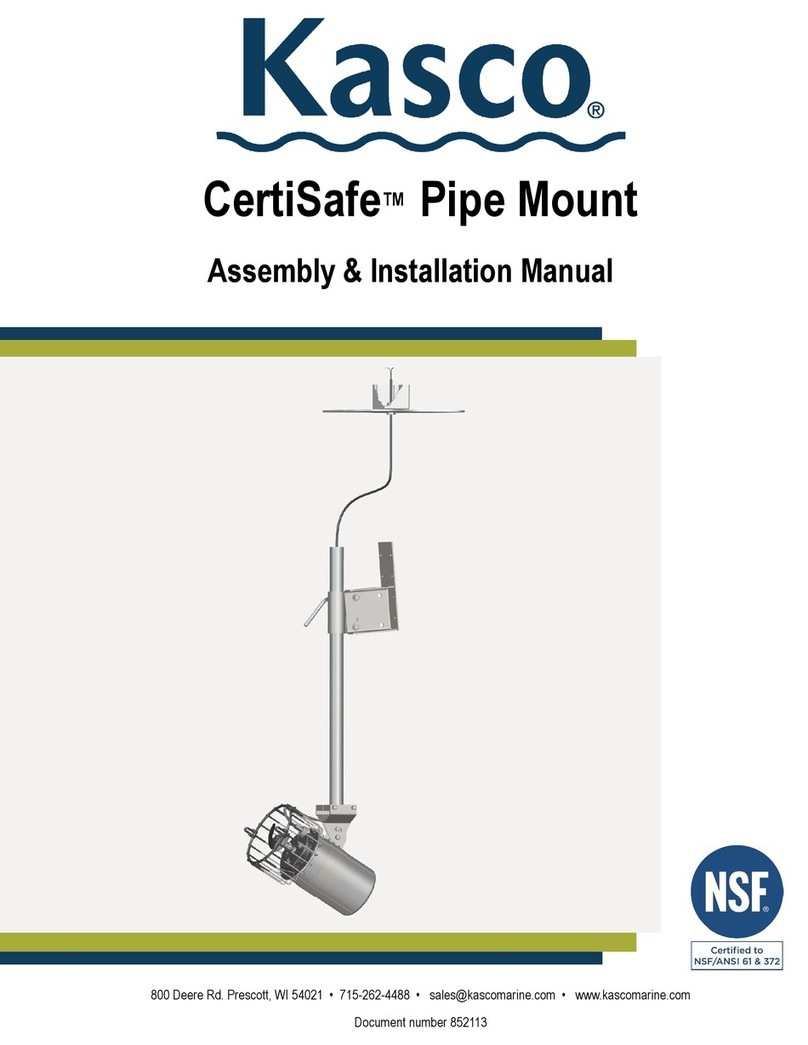
NSF
NSF Kasco CertiSafe PM-100 Assembly & installation manual
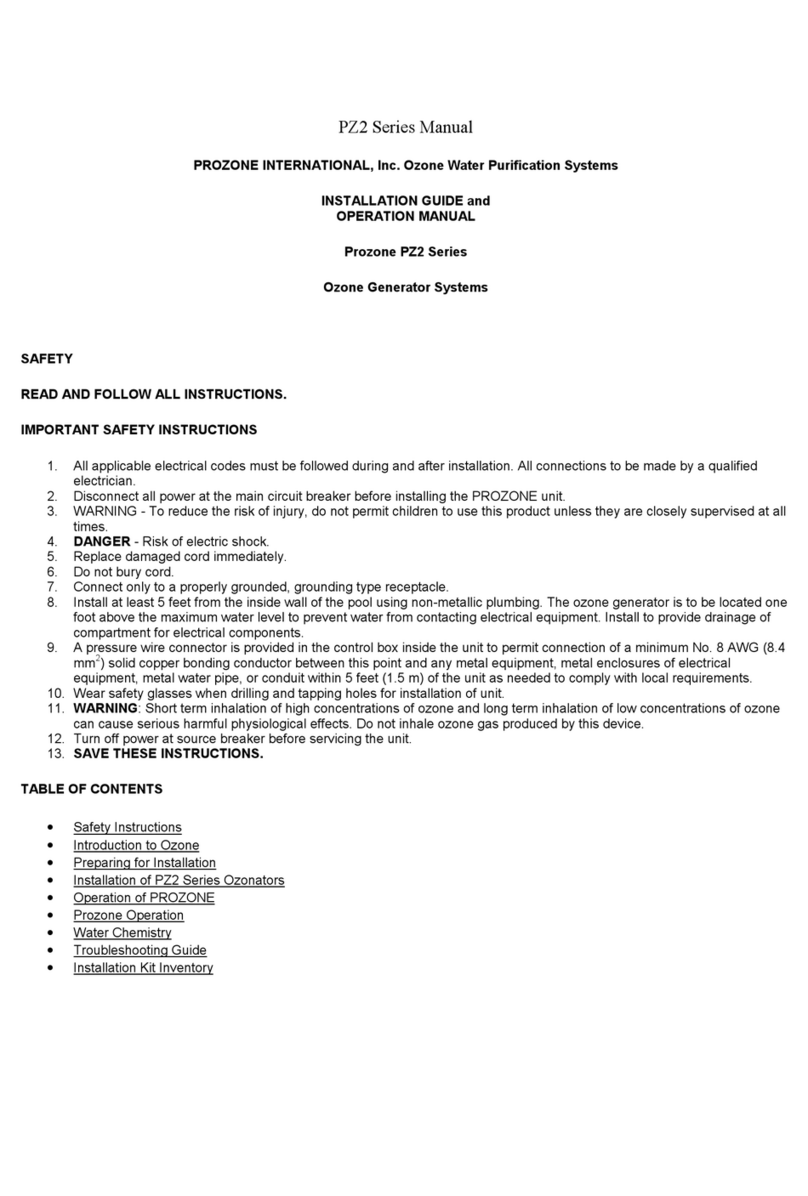
Prozone
Prozone PZ2 Series Installation guide & operation manual
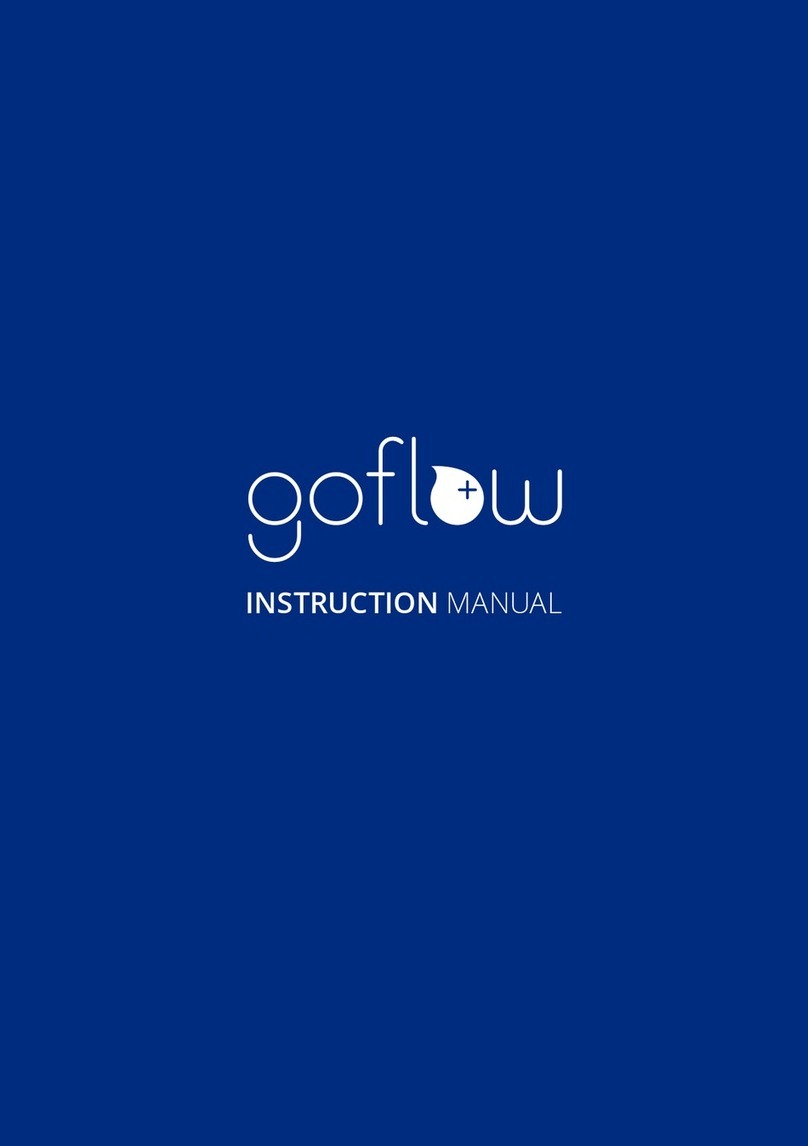
GOFLOW
GOFLOW GOFLOW instruction manual
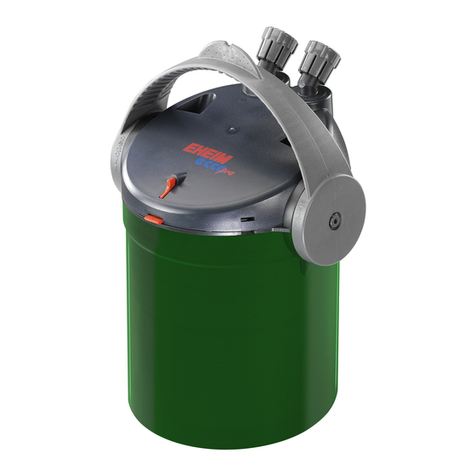
EHEIM
EHEIM ECCO PRO 2036 manual

Plymovent
Plymovent MDB GO Installation and user manual
